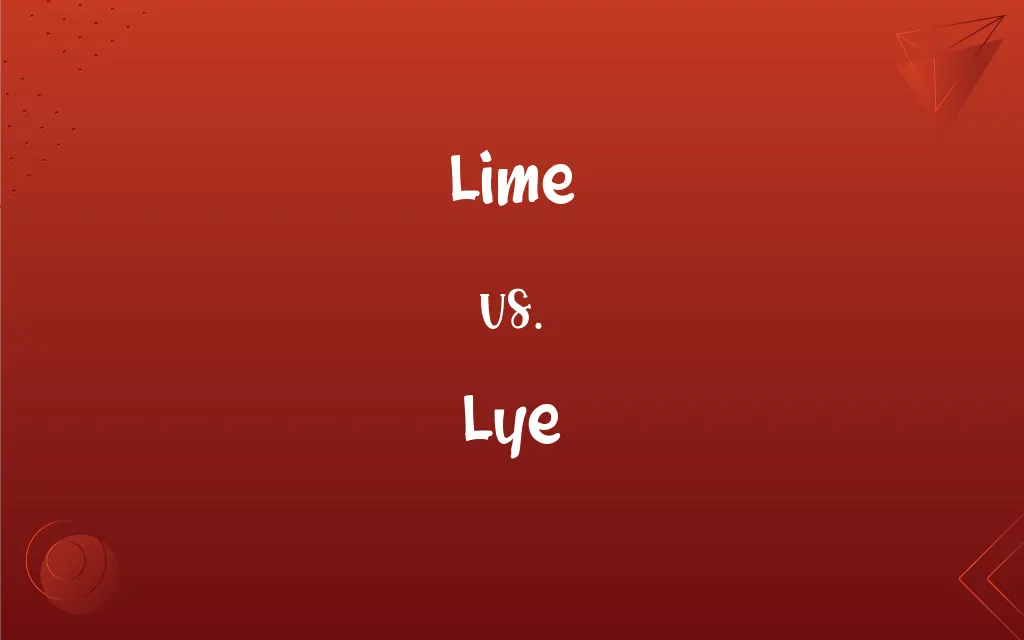Lime vs. Lye: What's the Difference?
Edited by Harlon Moss || By Janet White || Updated on October 2, 2023
Lime is a calcium-containing mineral or a citrus fruit, while lye is a strong alkaline solution often used in cleaning and soap-making.

Key Differences
Lime can refer to a variety of things, including the green citrus fruit or calcium-containing compounds like calcium carbonate or calcium oxide. It has applications in cooking, agriculture, and construction. Lye, on the other hand, is a strong alkali, typically sodium hydroxide or potassium hydroxide, used in soap-making, cleaning, and sometimes in food preparation.
In terms of chemical composition, lime is often a compound of calcium, carbon, and oxygen, depending on its form. Lye is composed of either sodium or potassium ions along with hydroxide ions. The two substances are not interchangeable because of their different chemical properties. Lime is often used to neutralize acidity in soil, while lye is used to break down organic matter.
From a grammatical perspective, both lime and lye are nouns but can also function as verbs. For example, you could say, "I need to lime the field" or "This soap was lye-d." However, 'lime' is much more frequently used as a verb than 'lye.' Also, 'lime' has more varied meanings, from a fruit to a mineral, whereas 'lye' mainly refers to a specific chemical substance.
Lime is usually safe for consumption in its fruit form and in moderated amounts in its mineral form. Lye, however, is caustic and can cause burns or poisoning if not handled correctly. Both substances have historical uses, but lye has a more limited application, primarily being used as a strong base in various processes.
Comparison Chart
Substance
Mineral or fruit
Chemical (alkaline)
ADVERTISEMENT
Composition
Calcium compounds or citrus
Sodium or potassium hydroxide
Uses
Cooking, agriculture, construction
Soap-making, cleaning
Safety
Generally safe
Caustic, hazardous
Grammatical Function
Noun and verb
Mostly noun, rarely verb
Lime and Lye Definitions
Lime
A white powder derived from limestone.
Lime is used in the production of cement.
ADVERTISEMENT
Lye
A caustic material.
Handle lye carefully as it can cause burns.
Lime
Any of several evergreen trees or shrubs of the genus Citrus having edible green or greenish-yellow fruit, especially the Mexican lime and the Persian lime.
Lye
A strong alkaline solution.
Lye is used to make soap.
Lime
The fruit of any of these plants, having a pulpy interior and usually acid juice.
Lye
Sodium or potassium hydroxide.
The chemical formula for lye is either NaOH or KOH.
Lime
See linden.
Lye
A substance used for cleaning.
Lye can unclog drains.
Lime
See calcium oxide.
Lye
The liquid obtained by leaching wood ashes.
Lime
Any of various mineral and industrial forms of calcium oxide differing chiefly in water content and percentage of constituents such as magnesia, silica, alumina, and iron.
Lye
See potassium hydroxide.
Lime
Birdlime.
Lye
See sodium hydroxide.
Lime
To treat with lime.
Lye
An alkaline liquid made by leaching ashes (usually wood ashes).
Lime
To smear with birdlime.
Lye
Potassium or sodium hydroxide (caustic soda).
Lime
To catch or snare with or as if with birdlime.
Lye
Obsolete spelling of lie
Lime
(chemistry) Any inorganic material containing calcium, usually calcium oxide (quicklime) or calcium hydroxide (slaked lime).
Lye
A short side line, connected with the main line; a turn-out; a siding.
Lime
(poetic) Any gluey or adhesive substance; something which traps or captures someone; sometimes a synonym for birdlime.
Lye
To treat with lye.
Lime
(theatre) A spotlight.
Lye
Obsolete spelling of lie.
Lime
A deciduous tree of the genus Tilia, especially Tilia × europaea; the linden tree.
Lye
A strong caustic alkaline solution of potassium salts, obtained by leaching wood ashes. It is much used in making soap, etc.
Lime
The wood of this tree.
Lye
Sodium hydroxide or potassium hydroxide, or a concentrated aqueous solution of either compound.
Lime
Any of several green citrus fruit, somewhat smaller and sharper-tasting than a lemon.
Lye
A short side line, connected with the main line; a turn-out; a siding.
Lime
Any of the trees that bear limes, especially Key lime, Citrus aurantiifolia.
Lye
A falsehood.
Lime
(uncountable) A brilliant, sometimes yellowish, green colour associated with the fruits of a lime tree.
Lye
A strong solution of sodium or potassium hydroxide
Lime
(fandom) A fan fiction story which contains sexual references, but stops short of full, explicit descriptions of sexual activity (coined by analogy with lemon).
Lye
A base used in various industrial processes.
Lye is used in the papermaking industry.
Lime
A casual gathering to socialize.
Lime
(transitive) To treat with calcium hydroxide or calcium oxide (lime).
Lime
(transitive) To smear with birdlime.
Lime
(rare) To ensnare, catch, entrap.
Lime
(transitive) To apply limewash.
Lime
To hang out/socialize in an informal, relaxed environment, especially with friends, for example at a party or on the beach.
Lime
Containing lime or lime juice.
Lime
Having the aroma or flavor of lime.
Lime
Lime-green.
Lime
A thong by which a dog is led; a leash.
Lime
The linden tree. See Linden.
Lime
The fruit of the Citrus aurantifolia, allied to the lemon, but greener in color; also, the tree which bears it.
Lime
The color of the lime{1}, a yellowish-green.
Lime
Birdlime.
Like the limeThat foolish birds are caught with.
Lime
Oxide of calcium, CaO; the white or gray, caustic substance, usually called quicklime, obtained by calcining limestone or shells, the heat driving off carbon dioxide and leaving lime. It develops great heat when treated with water, forming slaked lime, and is an essential ingredient of cement, plastering, mortar, etc.
Lime
To smear with a viscous substance, as birdlime.
These twigs, in time, will come to be limed.
Lime
To entangle; to insnare.
We had limed ourselvesWith open eyes, and we must take the chance.
Lime
To treat with lime, or oxide or hydrate of calcium; to manure with lime; as, to lime hides for removing the hair; to lime sails in order to whiten them; to lime the lawn to decrease acidity of the soil.
Land may be improved by draining, marling, and liming.
Lime
To cement.
Lime
Having a yellowish-green color like that of the lime (the fruit).
Lime
A caustic substance produced by heating limestone
Lime
A white crystalline oxide used in the production of calcium hydroxide
Lime
A sticky adhesive that is smeared on small branches to capture small birds
Lime
Any of various related trees bearing limes
Lime
Any of various deciduous trees of the genus Tilia with heart-shaped leaves and drooping cymose clusters of yellowish often fragrant flowers; several yield valuable timber
Lime
The green acidic fruit of any of various lime trees
Lime
Spread birdlime on branches to catch birds
Lime
Cover with lime so as to induce growth;
Lime the lawn
Lime
A green citrus fruit.
She squeezed a lime into her drink.
Lime
Calcium-containing mineral used to treat soil.
They applied lime to the acidic fields.
Lime
A color resembling that of the lime fruit.
The walls were painted a vibrant lime green.
Lime
The act of treating something with lime.
The garden underwent liming to improve the soil pH.
FAQs
What part of speech is 'lye'?
Lye is mostly a noun, rarely used as a verb.
Is lime edible?
Lime fruit is edible, but mineral lime should only be ingested in treated forms and in moderation.
Is lime a compound or element?
Lime is a compound, often containing calcium, carbon, and oxygen.
Can lime be used in gardening?
Yes, lime is often used to neutralize acidic soil.
Is lye a compound or element?
Lye is a compound, either sodium hydroxide or potassium hydroxide.
Are there multiple types of lime?
Yes, including the citrus fruit and various calcium-containing compounds.
What part of speech is 'lime'?
Lime is primarily a noun but can also be a verb.
Is lye edible?
No, lye is caustic and should not be ingested.
Is lime usually a safe substance?
Lime fruit is safe, and mineral lime is usually safe when handled properly.
Are there multiple types of lye?
Mainly sodium hydroxide and potassium hydroxide.
Can 'lime' function as a verb?
Yes, for example, "to lime a field."
Can lime and lye be used interchangeably?
No, they have different chemical properties and uses.
What is lye used for?
Lye is used mainly for soap-making and cleaning.
Can 'lye' function as a verb?
Rarely, but technically yes.
Is lye a hazardous material?
Yes, lye is caustic and can be hazardous.
About Author
Written by
Janet WhiteJanet White has been an esteemed writer and blogger for Difference Wiki. Holding a Master's degree in Science and Medical Journalism from the prestigious Boston University, she has consistently demonstrated her expertise and passion for her field. When she's not immersed in her work, Janet relishes her time exercising, delving into a good book, and cherishing moments with friends and family.
Edited by
Harlon MossHarlon is a seasoned quality moderator and accomplished content writer for Difference Wiki. An alumnus of the prestigious University of California, he earned his degree in Computer Science. Leveraging his academic background, Harlon brings a meticulous and informed perspective to his work, ensuring content accuracy and excellence.































































